Genevieve Dagobert
September 2022
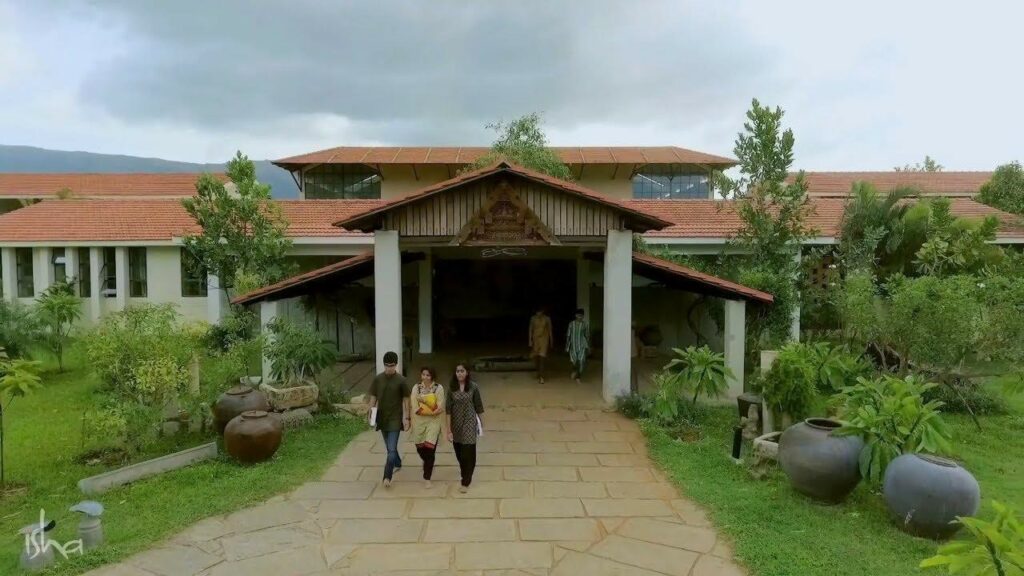
Dear Reader:
I am about to take you on a journey to the tranquil foothills of the Velliangiri Mountains in southern India to visit a school that you might have dreamt of but never thought possible. A school where children learn joyfully seven days a week, four-months at a time, in a parent-free, multi-age sibling atmosphere.
Welcome to Isha Home School, where for the past five months I had the opportunity to observe and participate in the community life that seamlessly blends the best aspects of ‘home’ and ‘school’ while fostering a culture of inspired teaching and passionate learning.
The vision of a multi-age classroom where children would be inspired and taught, not only by their teachers, but also by their peers*, has been germinating in the mind of the school founder for many years before its inception.
*Older students who have mastered any particular subject, are often seen helping others, who have not yet fully grasped it. The culture of mutual assistance is ever present. This of course does not mean that children copy their work from one another. The help is offered and received in unquestionable earnestness.
Isha Home School, a private, residential school was founded in 2005 by Sadhguru, a renowned Indian yogi, mystic and humanitarian. He summarizes his educational vision as follows:
“At Isha Home School, we strive to create the necessary platform where education is not about loading the child’s mind with information, but about making the child’s mind capable of razor-sharp perception, capable of knowing life in its full depth and dimension. Education is about expanding the horizons of human experience and becoming inclusive. Only in a state of inclusiveness can the empowerment of education become a bounty all of us may cherish.”
The school attracts and welcomes children from all over the world. To see boys and girls of all ages, races, and nationalities interacting with each other, learning, and playing together is a sign that no matter what humanity is experiencing right now, there is hope for tomorrow. A new generation of caring and responsible human beings is rising.

A Dream Come True
As a passionate lifelong educator, a trained Waldorf teacher, and a student of mysticism, I have been searching for many years for a school, which would not only teach children how to live, how to be, but most importantly would instill in them a deep sense of responsibility and commitment to humanity.
A school, which would inspire children to put the wellbeing of others above their own. When I first learned about Isha Home School, I knew that my search was over.
How the school is structured
Eighteen residential houses are scattered throughout the campus. Each of them bears the name of a flower. There are two junior houses, four middle schools, and twelve senior houses.
- Juniors are ages 7 to 9 [Grades 2 to 4]
- Middle Schoolers, ages 10 to 13 [Grades 5 to 8]
- Seniors are 14 to 17 year-old [Grades 9 to 13*]
*Most students choose to stay past the 12th grade for an additional year, to further refine and deepen their interests. This extra, unhurried time allows them to choose their future direction in life carefully and clearly. To inspire and broaden students’ horizons, the school regularly invites well known speakers and distinguished personalities who have achieved excellence in their respective fields to talk about their lives.
All students live with their house-parents, who are also their teachers, in a multipurpose residence which also serves as their classroom. This arrangement is well thought out, and specific nuances are prescribed for each age group:
- Juniors live and learn in the same house. They walk to other buildings on the school grounds for dining and specialty classes such as swimming, painting, drawing, modeling, Kalaripayattu*, or Bharatanatyam dance (schools major form of Indian classical dance).
- The Middle schoolers reside on the upper floor of their buildings and their learning space is on the ground floor.
- Seniors walk to their school (Gnana Shala) each day for approximately a quarter of a mile.
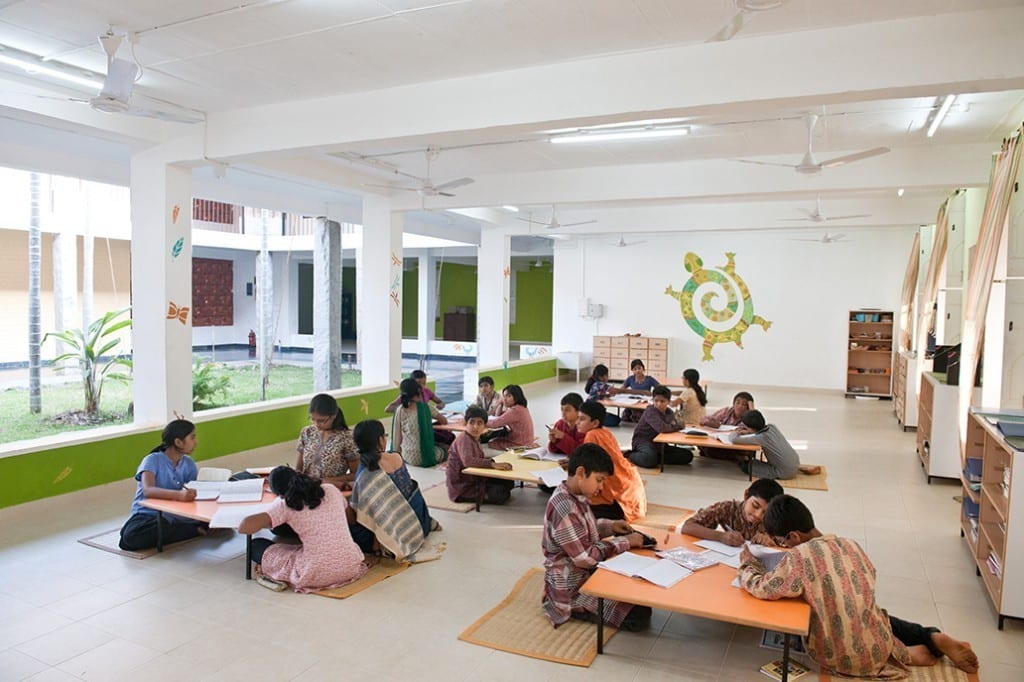
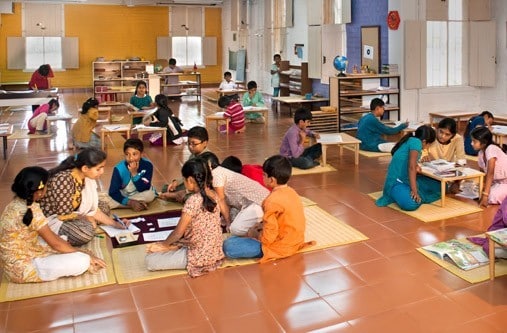
These subtle differences are all part of Sadhguru’s design of a conducive environment for the future leaders of humanity.

* Kalaripayattu is the world’s oldest martial art that helps the practitioner to establish balance and stability. Though its significance as a combat art has receded over centuries, Kalaripayattu is emerging today as a source of inspiration for self-expression in various dance forms. Practicing Kalaripayattu increases one’s flexibility and agility, strengthens the muscles and tendons by exercising the body without the need for any equipment.
The school is equipped with numerous playgrounds and fields for sports, games and performing arts, making it an extremely fertile place for children’s all around development.


A Glance at two Mystics: Sadhguru, a Yogi and Rudolf Steiner, an Anthroposophist
As a yoga meditator and a Waldorf teacher, I am deeply grateful to both of them for raising the consciousness of humanity and sowing the seeds of spirituality in all aspects of our lives.

Sadhguru on the Science of Yoga: “Over 15,000 years ago, predating all religion, in the mountains of the Himalayas, Adiyogi, the first Yogi, transmitted the science of Yoga to his seven disciples, the Saptarishis. He expounded 112 ways through which human beings can transcend their limitations and reach their ultimate potential. Adiyogi’s offerings are tools for individual transformation, as individual transformation is the only way to transform the world. His fundamental message is that “in is the only way out” for human wellbeing and liberation.”
Today, Sadhguru continues this tradition by transmitting the yogic sciences to millions of people around the world. The benefits of yoga practice are well documented by numerous studies conducted by Harvard researchers and others.

Rudolf Steiner (1861-1925) At the end of the 19th century, as a trained scientist and respected philosopher, Steiner formulated and taught a path of inner development he named “Anthroposophy”. Long before many of his contemporaries, Steiner came to the conclusion that western civilization would gradually bring destruction to itself and the earth if it did not begin to develop an objective understanding of the spiritual world and its interrelationship with the physical world. From what he learned through his clairvoyance, he brought practical holistic innovations in many fields of human endeavor: the arts, architecture, education, agriculture, medicine, social order etc.. In 1919 he founded the first Waldorf school in Stuttgart, Germany. Today, there are more than 1,092 Waldorf / Steiner schools in 64 countries, and 1,857 Waldorf kindergartens in more than 70 countries. These mystical seeds germinated and are to this day transforming the lives of millions around the world. Utmost gratitude!
In regards to their contribution to humanity, there are many similarities between these two initiates. Here are just two examples:
Education: While bringing their gift of education to humanity, both mystics chose not to engage “trained” educators, but instead they invited professionals from different walks of life. They were looking for individuals who were not influenced or affected by any particular teaching philosophy or methodology. Thus the first, founding faculty of both schools were passionate, open hearted, and dedicated individuals. They were beings of initiative who loved children, had a keen interest in the world, and always sought the truth. How grateful I am that “in spite” of my background, I was allowed to join this team of enthusiastic and dedicated human beings!
Agriculture: In 1924, as the highly mechanistic view of nature was beginning to take hold in agriculture, farmers approached Dr. Steiner with their concerns about the declines they were noticing in the health and fertility of their soil, plants, and animals. In response, Steiner presented an “Agriculture Course” to a group of 111 farmers in which he brought the perspective of increasing the organic content in soil by integrating crops, animal waste, and by recommending the creation of a closed-loop system of fertility. Biodynamic Agriculture was born! Today, the largest Biodynamic association is located in Bangalore, India.
Isha Foundation’s major environmental initiatives: As the suicide rate of Indian farmers was increasing due to wide-spread land degradation, Sadhguru launched a number of projects:
- Project Green Hands: Launched in 2004 to increase the green cover, restore soil health and manage natural resources appropriately. So far this project has successfully overseen the planting of more than 17 million saplings by over 2 million volunteers.
- Rally for Rivers: a month-long, nationwide campaign launched by Isha Foundation in 2017 to address the scarcity of water across rivers in India and instill awareness about protecting rivers.
- Cauvery Calling: supporting farmers in planting an estimated 2.4 billion trees through agroforestry, thereby covering one third of Cauvery basin with trees as a means of conserving it.
In March 2022, Sadhguru launched a Global Save Soil Movement to address the soil crisis by bringing together people from around the world to stand up for Soil Health, and supporting leaders of all nations to institute national policies and actions toward increasing the organic content in cultivable Soil. The movement recommends raising the organic content by bringing the land under shade and enriching the soil through plant litter and animal waste.
Yoga at the school
All aspects of the school are designed to kindle within every child the innate urge to learn and know. Therefore, the primary focus is not only on sharpening the intellect and stabilizing the students’ body, mind, and emotions, but also to provide them opportunities to explore other dimensions of life without even being taught. It is important to note that at no point in their entire schooling, is there any spiritual message imparted to the children. Sadhguru clearly states that children breathe spirituality without even knowing it. The teachers are expected to take care of their own personal inner development rooted in the Yogic science. Once the house-parents and teachers are themselves loving, joyful, articulate, and peaceful, the children will naturally be inspired to learn and will grow in a joyful and harmonious environment. This, I must say with profound gratitude, is what I observed first hand every single day of my internship. Throughout each day, the sound of children laughing, singing, and playing echoed throughout the premises.
Yoga plays a fundamental role in achieving this balance. Children practice it every morning from 5:45 to 6:15.

Why Yoga?
Sadhguru shares the following about Yoga:
“In the Western part of the world, if you utter the word “Yoga,” people think of impossible physical postures. This is a very distorted idea of what Yoga is. Yoga is not about bending and twisting your body or holding your breath. It is a mechanism and a technology to get you to that state of experience where you see reality just the way it is. The word “Yoga” literally means “union.”
As you sit here, your idea, your sense and experience of who you are is very strong. You are here as an individual. But what the trees are exhaling right now, you are inhaling; what you are exhaling, the trees are inhaling. In other words, one half of your lung is hanging out there. This is not just in terms of breath. Today, modern physics is proving to you that as you sit here, every subatomic particle in your body is in constant transaction with everything else in existence. If this transaction stops, you will cease to exist. So, Yoga means to know the union of existence by experience.”
Q: At what age should children learn yoga, and what types of yoga should they practice?
Sadhguru:
“Isha Yoga for Children* offers a unique possibility for every child to experience a joyful blossoming of their natural potential. Isha Yoga celebrates the natural gifts within every child, including wonder and a sense of oneness with life. The program introduces simple yoga for children, led through an exploration of fun, love and joy. The sessions are offered by trained Isha Foundation teachers.
Nada Yoga or the yoga of using sounds is a wonderful way for children to start yoga. Nada yoga is the simplest and subtlest way for a child to begin. It leads to wellbeing and the proper development of body and mind. There are also practices such as Yoga Namaskar, which can be learnt even at seven years of age. There are also Upa-Yoga techniques, which both children and adults will find useful.
When children start seeing the benefits of these practices, when they see that these techniques can set them apart in a group of people in terms of capability, they will naturally pursue higher forms of yoga. As they grow up, their yoga should also grow.”
* Some of Isha Yoga classes for children and adults are available on Youtube.
Daily Periods of Silence
Each school assembly and every class start with an invocation and a brief period of silence. A bell is rung and all children, while sitting on the floor in a cross-legged posture, close their eyes and remain silent for a few minutes. The same happens at bedtime.
Just 2 months into my internship, I was asked to substitute for a house parent right before bedtime. After having asked the children to change into their pajamas and brush their teeth, without even waiting for my direction, they all sat quietly in total stillness on their beds for 5 minutes. At the end, I called them one by one, invited them to lie down, and wished them all a good night.
Sadhguru maintains that stillness and silence play an important role in helping children to be balanced, alert, and focused.
One can appreciate how all these elements working together are helping students to face with ease into whatever situations life may bring.
Languages learned
Starting in Junior school, not one, but three different Indian languages are introduced: Sanskrit, Tamil, and Hindi. Children learn to read and write in these languages through movement, stories, chants and songs.
To my surprise and admiration, one morning I heard an eight-year-old conversing in Sanskrit with his teacher. I waited until the end of the conversation and approached the teacher to confirm if what I had heard was correct. This is a testament to the beauty and power of the human brain.
Sadhguru describes the nature of the Sanskrit language as a “powerful tool to experience a deeper dimension of existence.” He adds, “The Sanskrit language is a device, not necessarily a medium of communication.”
Unlike any other language, Sanskrit has to be learnt by chanting and constant repetition. It does not matter whether one understands the meaning or not. The sound itself is what is important, not the meaning of the words. As Sadhguru says: “Meanings are made up in your mind. It is the sound and the form which are connecting. Are you connecting or not? – That is the question. That is why Sanskrit has become the mother of almost all Indian and European languages, except Tamil. All the other Indian languages and almost all the European languages have their origin in Sanskrit.”
Conscious Chaos
Yes, the idea of creating and maintaining a constant, conscious chaos is the bedrock of Isha Home School philosophy. You may ask: Why would any school want to advocate chaos instead of order?
The carefully planned elements of surprise, or better yet, ambush at school may not even compare to “real life” situations, but it surely teaches students to be flexible and be able to adjust to whatever life may bring. These are the qualities of future leaders.
“This confusion in school is well-planned, much like the way a flash mob in a crowded place, which seems to appear out of the blue when in reality, quite a lot of planning and practice is involved.”
On any given day, you may observe “back-to-back classes, changes of schedule (morning assembly being moved to mid-day), games, dining, unannounced renowned guests, surprise late-wakeups, visits to the clinic, celebrations, concerts, electives, etc. For the first time visitor, it may all appear as a recipe for disaster or over-exhaustion! But as Sadhguru explains: “The struggle that one has to go through in chaos enables one to survive and flourish. A philosopher who was breeding butterflies saw the struggle that a fledgling butterfly had to go through to break out of the cocoon. Out of his sense of compassion, he used his fingernail to cut the cocoons for a batch of butterflies. They never could fly.”
The orderly and perfect structures we so often create for ourselves, leave no room for evolution, which is the very essence of life on this planet and of the entire cosmos.
I have witnessed constant, unexpected changes received and handled by students and teachers with utmost grace and acceptance. Of course, there would be occasional minor complaints, but no one would ever get overly upset.
This is only a small taste of what life will be like in the future, says Sadhguru: “Now is the time to prepare our students. Therefore, the question to ask is: Confusion vs Confidence? Confusion definitely is the way to go. It means that you constantly want to look. You are not dead sure about anything.”
Everything at IHS, whether it is collaborative style of learning, crafted confusion, yoga practices, Indian Classical music, or students routinely making their beds, washing their dishes, and cleaning their bathrooms, is geared towards helping each student to become a conscious, caring, and responsible human being. Using the teachers as role-models, students are being prepared to make this world a better place. Every day, a seed is being planted for a future world where no one focuses solely on their own wellbeing and benefit, (my job, my family, my house, my car, etc.) but instead on the wellbeing of the entire human community.
How about Field trips?
Of course, they are also part of the Isha Home school experience. Whether it is a trip abroad, a ten-day trek to the Himalayas, a rafting adventure in the waters of the Ganga river, or a field-trip to the sacred temples of India, they all further enhance students’ learning and expose them to the beauty and richness of the world.

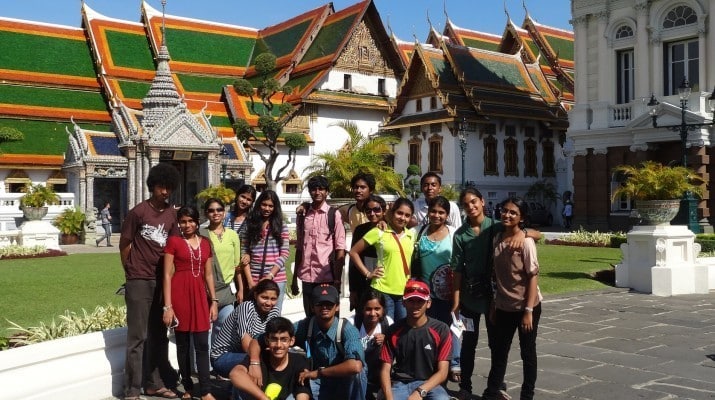
An alumnus shares his experience
“To me, the beauty of this place is beyond comparison. Unlike the hustle and bustle of city schools, Gnana Shala brings so much more peace and calm. I never imagined that reading a fat economics textbook under the shade of a tree could be an enjoyable affair nor did I ever experience the pleasure of dipping my fingers in a pond of tiny fishes while chatting with my buddies. I did not think that even after coming home drenched in rain, mud and sweat, I would readily (okay, maybe not too readily) wake up the next morning at 5:30 am.”
Looking ahead…
To prepare children responsibly for whatever the future holds, the ultimate goal of education is that the mind does not become a limitation but a possibility. At IHS we invoke and cherish a vivid imagination in children and strive to imbue it with consciousness…
SG: “As adults, we have lived in this world very irresponsibly. In the future, children will have a lot of work to do, even if we don’t do further damage. At Isha Home School our ultimate goal is to produce children who will be able work through any disaster with gracefulness and sense.”
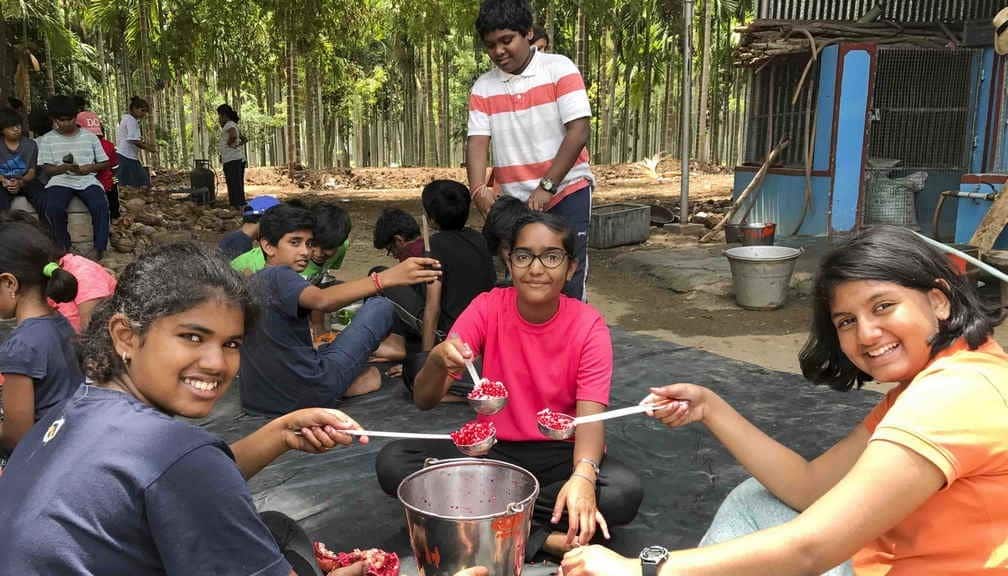
****
